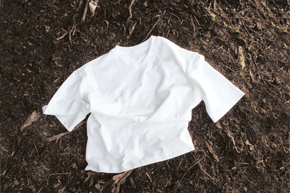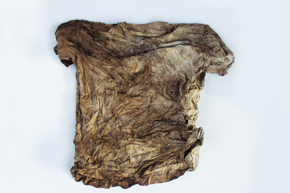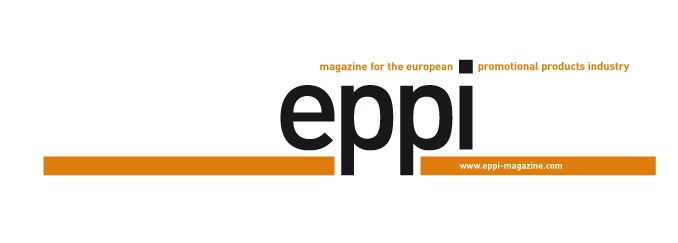Compostable T-shirts, worry-stones made of magnesium or pencils as a haptic explanatory tool – if it was down to the graduate chemist and process technician, Prof. Michael Braungart, intelligent design would shape the world of tomorrow, where consumption can be lushly celebrated and the bad ecological conscious lands in the garbage. Incidentally, that is the only thing that lands there.
Mr. Braungart, you are the co-founder of the Cradle to Cradle principle (C2C). This entails products already being designed at the development stage in such a way that their individual components can be fed back into the recycling cycle without a loss of quality. Don’t the domestic environmental protection measures go far enough for you?
Michael Braungart: We have to stop seeing ourselves as parasites. Up until now the environmental measures only involved saving energy, reducing the water consumption or producing less waste. However, this has nothing to do with protecting the environment, it is simply polluted slightly less. In terms of child protection that would mean: Protect your children by hitting them less. Our approach is totally different: People can be useful, not less harmful. Completely following the role model of nature, which knows no waste. Its waste is always nourishment.
This puts a new spin on the sustainability discussion…
Michael Braungart: This discussion comes from the North, from Scandinavia. Perhaps one has to save, avoid and do without more there in order to get through the winter. Maybe every footprint is destructive there, because it leads to soil erosions. If, however, I run alongside the Rhine or the Danube, then every footprint becomes a small wetland. That is the southern view, which celebrates people for their footprints. The Brundtland Commission defines sustainability as development that corresponds to the needs of today’s generation, without endangering the possibilities of future generations. That is a sad concept and it is as if one were to come home and say to one’s kids: I don’t want to endanger you, I am going to be child-neutral today.
There are simply far too many absurdities, because existing products are designed in an extremely primitive way. For example, if one touches a till receipt, two dozen chemicals are absorbed through the skin because of the thermal paper, these can be detected later in the breast milk. Every till receipt, every parking ticket is a pile of hazardous waste. Something has to be done about this.


Cradle to cradle demands consistent thinking in endless material cycles and formulates the vision of a world without waste. How can this work in spite of our consumption?
Michael Braungart: We have to design our nutrient cycles intelligently – either in biological or technical cycles. Everything that wears down or is used up, i.e. shoe soles, brake pads or washing powder has to be of biological use. It has to be designed as environmentally-friendly as possible, so that it can subsequently be thrown on the compost heap without hesitation. Everything that can only be used or operated, such as washing machines, TVs or computers has to be made technically usable. The technical nutrients have to be fed back into the production cycles again – without losing any material value.
What is the consequence of this for product development?
Michael Braungart: We can take 40 years of apocalypse discussions as an opportunity for innovation and completely redesign products. For instance, if the manufacturers would sell the service “wash 3,000 times” instead of a washing-machines, they could use the best materials to make the appliance. Instead of on average 150 used, mostly cheap plastics, five different plastics could be implemented for building the machines, which could later be implemented in the techno sphere again. In this way, not only better, but also more favourably-priced products would arise, because the intelligence is invested into the product design and not into downstream filters or waste systems. In the same way, window builders could sell the services “heat insulation and perspectives” instead of windows. And why should I be interested in 4,360 chemicals when all I actually want to do is watch television? While I was taking my degree, I was accused of being an eco-communist for posing this question. However, the young people of today tick differently: They don’t have to own everyday items such as cars for instance, they just want to use them.
Which products are already being produced for such closed cycles?
Michael Braungart: We have been occupying ourselves with the redesign of products since the beginning of the 1990s. For example, we developed compostable, so to speak “edible” upholstery for the Airbus 380, which can be fed back into the biological cycle as nutrients, i.e. as peat substitute. This would be inconceivable with conventional furniture upholstery, it namely has to be burnt as hazardous waste.
Special carpets that we designed together with a Dutch company called Desso are an innovative example of a product that can be circulated within the technical cycle. These are not only non-toxic, they actually also actively free the air from particulate matter. In other words, the carpet takes over responsibility for doing what otherwise the lung should be doing. The company’s profit margin with these products is significantly higher than 25%.
Textiles are an important product segment of the promotional products industry. Are there already any best practice examples here?
Michael Braungart: In 2006, we developed the first compostable T-shirt together with the clothes manufacturer, Trigema, which is indeed suitable for contact with the skin – from the organic cotton, to the bio-degradable dyes, through to the seams. For the first time ever, C&A also offered 400,000 Cradle to Cradle certified T-shirts made of organic cotton this summer, which in the meantime can also be produced in countries like Bangladesh or Vietnam.
When haptic advertising media can be designed in this way, then they are a wonderful form of communication because they stand for a culture of generosity and bestowing gifts. Otherwise, companies simply hand over hazardous waste to their customers.
Do you have a few concrete ideas for the industry?
Michael Braungart: Promotional products should be used to inspire people and to bring them real joy. Then they are no longer just an advertising gimmick, but indeed an innovation platform that shows the people what the future can look like. However, all this has to be completely redesigned. For instance one could develop worry stones out of magnesium, which on being rubbed enable vital minerals to be taken in. That would be a wonderful promotional product that the recipients would really benefit from, especially since nearly all people suffer from a magnesium deficiency.
Furthermore, haptic explanatory tools would be not only be an ideal solution for presenting new materials, but they also make them sensually experienceable. For example, I could treat a pinewood stick with a preservative and thus make it as durable as teak. The advertising message could then be conveyed using the corresponding promotional product, i.e. a pencil: Stable terraces can not only be built from teak, but also from domestic woods.

In 2008, Desso set off on the path of becoming a C2C company. The EcoBase rear coating is produced out of 100% positively evaluated components and can be completely recycled at the production sites. Furthermore, the AirMaster carpet tiles bind particulate matter and thus improve the quality of ambient air.
This means companies could draw on plentiful sources for promotional products without having a bad ecological conscience…
Michael Braungart: …or one rents out haptic messengers for a certain period of time. For instance, companies could implement calendars that are taken back at the end of the year so that something new can be created out of them. In this way, the companies stay in contact with their customers and would not send useless stuff to people year after year, who are perhaps not even at the company anymore.
Cradle to Cradle is a school of thought and at the same time a quality seal that is awarded by the Cradle to Cradle Products Innovation Institute, which among others certifies the use of eco-friendly, healthy and reusable materials (technical recycling or composting)…
Michael Braungart: In the meantime, there are already over 8,000 certified Cradle to Cradle products from a wide range of different sectors. For instance, Stabilo not only uses waste polypropylene from its production cycle for its C2C pen, but has also developed the first biologically harmless writing liquid. As such, the quality of the paper remains the same, whereas conventional pens make hazardous waste out of it.
Your approach requires a radical reorganisation of our economic system. What sort of timeframe can we reckon with here?
Michael Braungart: Many things are happening here, among others in the Netherlands, but also in the USA, Denmark, Austria, Switzerland and Germany. In Taiwan a Cradle to Cradle alliance was even founded that unites the government, companies, NGOs and research institutions – with the aim of turning Taiwan into a C2C island. So, companies that produce in Asia are in good hands there, not least because the government supports C2C certifications.
But of course historical changes take time, even if one has long since understood the fundamental truths. For example, almost 130 years lay between the proclamation of the human and citizen rights and the women being able to vote in Germany. When one contemplates such periods of time, one learns to become more modest.
However, I am sure that the industry society will have completely changed over to Cradle to Cradle by 2040. Alone in Germany there are several hundred people active here, including numerous young designers, who not only want to make the products more attractive, but also completely redesign them from scratch and this will thus become a key factor of the production.
// Andrea Bothe spoke to Michael Braungart.




